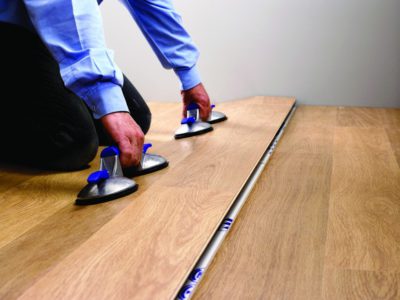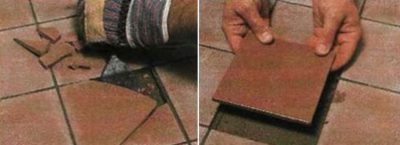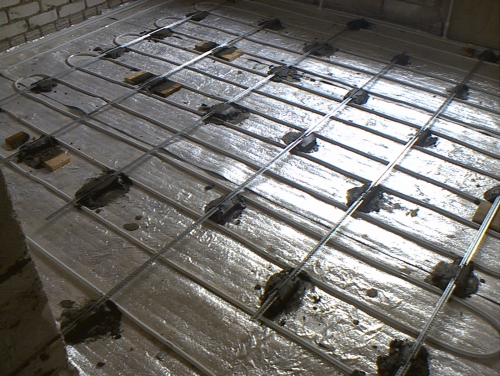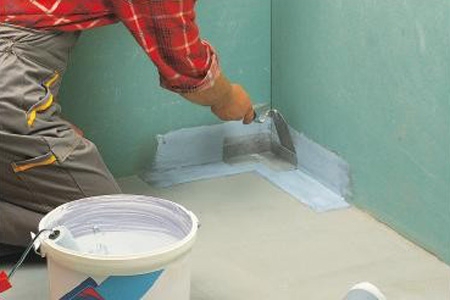Do-it-yourself floor repair: a guide for fixing all possible coatings
Do-it-yourself floor repair is a complex and time-consuming process. But if there is a desire and some skills, then any work on the shoulder. What kind of manipulations will an enthusiast have to face? Let's try to figure it out. Basically, it all comes down to assessing the condition of the supporting structure and strengthening it, as well as restoring or replacing (partial or full) of the finish floor covering. In some cases, the need for repair of floors may be caused by a decision to make additional thermal insulation measures.
Concrete floor repair
To implement concrete floor repair, it is necessary, first of all, to dismantle the protective and decorative coating. Before embarking on pouring a self-leveling compound, it is advisable to dry the screed for several days.
If present large cracks it is worth thinking about removing the old concrete base and forming a new one.
Before restoration of the floor, its surface should be cleaned of dust and destroyed particles (either with a vacuum cleaner or by sweeping with a brush). Fat and other spots are removed by abrasive composition (base - chalk, talc and quartz sand) or by chemical solvents.

Then the concrete surface must be primed with a special solution or PVA with water (1: 4, respectively) and left for a day.
Now you can putty all the potholes and, waiting for them to dry completely, set about applying a new layer of screed. Almost any coating can be laid on the restored concrete base.
Restoring a wooden floor
If you are a happy owner of wooden floors, then the first step in the repair process should be the identification of creaking floorboards, which are also affected by microorganisms (mold and fungus). First of all, you should arrange access to the lags - either through the basement, or by removing several boards.
Mold that has hit boards and logs must be eliminated - the damaged layer is removed as much as possible. Then the entire floor is treated with special antifungal impregnation. But just this measure is not enough - if you do not identify the place of moisture condensation and do not lay waterproofing materials, the mold will return again.
If the area spoiled by the fungus to the ugliness is large, you will have to remove all the boards together in the upper layer of soil. Only surface treatment with an antiseptic composition and the formation of an expanded clay layer will protect the new floor from such deplorable consequences.
Your wood flooring "Torment" the gap? Do not know how to fix them, but really want to carry out repairs? Then the video guide attached below will help to understand the intricacies of the question.
Laminate floor repair
Laminate, like many other floor coverings, is prone to scratches, dents, deformations. The benefit of eliminating coating defects is quite simple.
You can get rid of stains from varnish and paint with acetone, hide scratches with a wax pencil. Special repair pastes will help to cope with small dents.
It's no secret that the most vulnerable place in the laminate is the castle joints. If they are seriously deformed due to the ingestion of an abundant amount of liquid, then these areas of the coating must be replaced (removed). There are no options.

Surely, you yourself understand that it will not be possible to do this with an adhesive laminate - it is impossible to accurately dismantle damaged panels. In this case, all flaws will have to be sealed with acrylic sealant or wood putty.
Ceramic floor repair
Ceramic tile floors are highly durable, respectively, less often than others need repair. But still ... If cracks formed in the tiles, they should be filled with cement milk. For this, cement milk is poured onto the tile and with a swab they begin to rub it into the crack - first along, then across. The restored place is covered until the final solidification of the solution.
The tiles that bounced during operation are glued again; destroyed and lost their appearance is replaced by new ones.

Subtleties of polymer floor repair
The vast majority of defects in the polymer floor arise as a result of a violation of the technology of their device. The most common defects of this type of flooring are:
- discoloration of the surface;
- the appearance of roughness;
- exfoliation of the film;
- cracking;
- and the saddest thing is the peeling of the polymer layer.
The listed flaws, with the exception of the latter, can be eliminated by:
- complete removal of problem areas;
- thorough preparation of the concrete base;
- applying a new polymer layer (it is extremely important to observe the correct technology for its preparation).
How to improve linoleum?
Linoleum repair make pretty easy. Typically, damage such as small swelling, cracks, and tears is done by injecting special glue under the cover (using a syringe). Linoleum is pressed to the base, straightened and placed on top of a small load.
If large sections of linoleum are damaged, they are removed and replaced with new ones.
Carpet Transformation
It is not difficult to eliminate defects in the carpet - it is enough to have spare pieces of it. The patch should be cut off simultaneously with the restored coating - use an edge trimmer and a ruler (preferably metal). Fix it over the damaged area using adhesive tape. Put a patch on a double-sided tape or glue.

Latex glue should be applied to its edges first (prevention of thread loosening).
Attention! Exact coincidence of the line pattern / direction of the pile is required! Otherwise, the repaired area will become an eyesore.
The joints between the coating and the patch are leveled with a smooth, hard object.
As you can see, the nature of floor repair directly depends on what specific materials and technologies were used during its “erection” - in each case, a special approach and technique are required. We sincerely hope that after reading our guide you will succeed!




